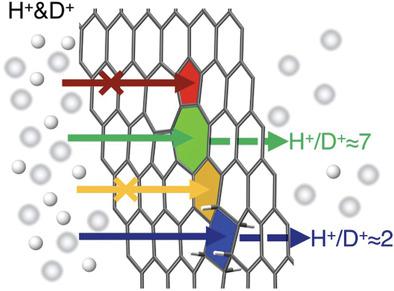当前位置:
X-MOL 学术
›
Adv. Mater.
›
论文详情
Our official English website, www.x-mol.net, welcomes your
feedback! (Note: you will need to create a separate account there.)
Stone-Wales Defects Cause High Proton Permeability and Isotope Selectivity of Single-Layer Graphene.
Advanced Materials ( IF 27.4 ) Pub Date : 2020-08-02 , DOI: 10.1002/adma.202002442 Yun An 1, 2, 3 , Augusto F Oliveira 1, 3 , Thomas Brumme 2 , Agnieszka Kuc 1 , Thomas Heine 1, 3, 4
Advanced Materials ( IF 27.4 ) Pub Date : 2020-08-02 , DOI: 10.1002/adma.202002442 Yun An 1, 2, 3 , Augusto F Oliveira 1, 3 , Thomas Brumme 2 , Agnieszka Kuc 1 , Thomas Heine 1, 3, 4
Affiliation

|
While the isotope‐dependent hydrogen permeability of graphene membranes at ambient condition has been demonstrated, the underlying mechanism has been controversially discussed during the past 5 years. The reported room‐temperature proton‐over‐deuteron (H+‐over‐D+) selectivity is 10, much higher than in any competing method. Yet, it has not been understood how protons can penetrate through graphene membranes—proposed hypotheses include atomic defects and local hydrogenation. However, neither can explain both the high permeability and high selectivity of the atomically thin membranes. Here, it is confirmed that ideal graphene is quasi‐impermeable to protons, yet the most common defect in sp2 carbons, the topological Stone–Wales defect, has a calculated penetration barrier below 1 eV and H+‐over‐D+ selectivity of 7 at room temperature and, thus, explains all experimental results on graphene membranes that are available to date. The competing explanation, local hydrogenation, which also reduces the penetration barrier, but shows significantly lower isotope selectivity, is challenged.
中文翻译:

石质缺陷会导致单层石墨烯的高质子渗透性和同位素选择性。
尽管已经证明了石墨烯膜在环境条件下的同位素依赖性氢渗透性,但在过去的五年中一直在讨论其潜在机理。报道的室温质子-氘化氢(H + -D +)选择性为10,远高于其他竞争方法。然而,尚未了解质子如何穿透石墨烯膜-提出的假设包括原子缺陷和局部氢化。但是,都不能解释原子薄膜的高渗透性和高选择性。在这里,已确认理想的石墨烯对质子是准不渗透的,但它是sp 2中最常见的缺陷碳,即Stone-Wales的拓扑缺陷,在室温下计算出的穿透势垒低于1 eV,H + -over-D +选择性为7,因此,可以解释迄今为止在石墨烯膜上的所有实验结果。竞争的解释是局部氢化,它也降低了渗透屏障,但显示出较低的同位素选择性,受到了挑战。
更新日期:2020-09-15
中文翻译:

石质缺陷会导致单层石墨烯的高质子渗透性和同位素选择性。
尽管已经证明了石墨烯膜在环境条件下的同位素依赖性氢渗透性,但在过去的五年中一直在讨论其潜在机理。报道的室温质子-氘化氢(H + -D +)选择性为10,远高于其他竞争方法。然而,尚未了解质子如何穿透石墨烯膜-提出的假设包括原子缺陷和局部氢化。但是,都不能解释原子薄膜的高渗透性和高选择性。在这里,已确认理想的石墨烯对质子是准不渗透的,但它是sp 2中最常见的缺陷碳,即Stone-Wales的拓扑缺陷,在室温下计算出的穿透势垒低于1 eV,H + -over-D +选择性为7,因此,可以解释迄今为止在石墨烯膜上的所有实验结果。竞争的解释是局部氢化,它也降低了渗透屏障,但显示出较低的同位素选择性,受到了挑战。











































 京公网安备 11010802027423号
京公网安备 11010802027423号